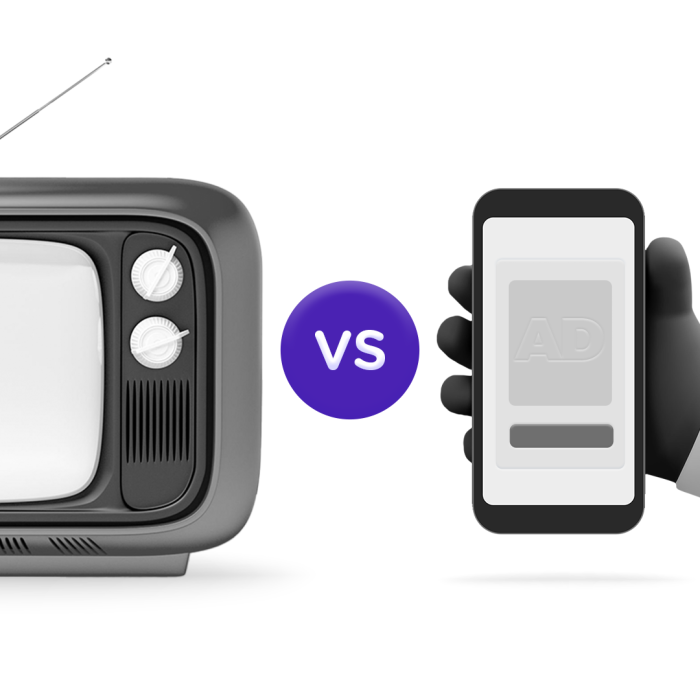With the continuous penetration of mobile and internet connectivity, businesses seeking to advertise their products or services often have to broaden their channels beyond radio and TV, even if they continue to use the same medium, in a world where the number of cord-cutters grows by the day. This has made social media ads popular among businesses and their audiences. In the following blog post, we’ll look at the differences between these two channels, focusing on how they target their audiences, what the main differences are in terms of user experience, the costs associated with each type of advertising, and accuracy (or lack thereof) when targeting a specific audience. TV ads or social media ads? That is the question!
Advertisers can reach out to target customers through social media and television formats. Your company may prefer a concentrated message approach that sometimes emphasizes only one of these media types. Integrated approaches, on the other hand, rely on both media to reach and impact customers. When deciding between advertising mediums, such as television versus social media, it is helpful to understand how each medium works to select the mixture that makes the most sense for your business and audience.
Various costs per channel
The costs of both media channels are vastly different. In terms of absolute cost, television has traditionally been the most expensive medium. Even in domestic markets, producing a TV commercial can cost tens of thousands of dollars. Then you’d spend at least a few thousand dollars more to purchase a package of ads on a domestic TV channel for a specific period. On the other hand, self-managed media has little to no placement costs, even though you must pay employees to operate your accounts. You typically pay by the hour or message volume when you outsource social media.
Various message formats
Because both media provide different message formats, comparing and contrasting social media and TV ads cannot hurt. TV has one of the most diverse sensory appeals and creative opportunities. Characters, motion, visuals, written and verbal copy, sound, and product demonstrations can all be used to tell stories. Social media includes everything from video streaming on YouTube to short text copy exchanges with marketing on Twitter or Facebook.
Evolving engagement level
The rise of social media has coincided with a greater emphasis on customer engagement in advertising. This means that businesses want more direct, real-time, and interactive customer interactions that provide instant feedback and personal connections. Companies can view their audience’s engagement with their advertising more easily now that social media sites track shares and hashtags. People can even tweet or message businesses in real-timetime. Tv ads are part of the old guard, known for passive messages that create a memorable effect that ultimately leads to purchasing or engagement activities. Follow-up research is usually required to determine whether or not customers got the message and reacted. However, this does not necessitate an either-or situation. As a result, social media vs television may not be necessary; television commercials can be featured on social media, and social media sites can be plugged in during Tv ads.
Social media targets its audience with surgical precision.
While TV advertising appears to be hit-or-miss, the same cannot be said of social media promotion, at least not the paid variety. Advertisement on this channel allows brands to reach a wide or narrow audience. Age, gender, and location are among the criteria, as are interests and job titles. Brands would just have to assume that every targeted person is honest about the details on their social media profiles, but even if this is not the case, the number of deviations is still lower than in the case of TV advertising.
TV ads are limited to video.
Because there aren’t many other options besides video, TV ads are somewhat limited in terms of format. Normally, this would not be a problem because the video is a sensory-appealing medium that can include powerful audio and written copy and meaningful still or moving images. Nonetheless, social media ranks higher due to its lack of constraints. Audio? Check! Video? Check! Images? Check! And everything is beautifully complemented by a relevant written description.
Why do large corporations continue to advertise on television rather than social media?
Nowadays, very few large public-facing companies advertise in only one medium. Chances are, any large company you’re considering advertises on social media in addition to television advertising. You just might not have noticed. There could be several other reasons for your perception that “big companies still advertise on TV rather than social media”. Some are:
1. It is working.
Your question may, in some ways, answer itself. There is no better proof of efficiency than the fact that you are aware of their TV ads but not their social media advertising.
2. It is part of a larger campaign known as the 360 campaign.
Television advertising is frequently used as part of a larger advertising and marketing strategy. And television plays a very specific role in this. Therefore, Television remains an excellent way to reach many people and raise brand awareness, while social media is frequently used in various strategic ways. They are both specific tools with specific applications and advantages in a much larger arsenal.
3. TV has a wider audience.
The number of people who see a communication is measured as its reach. It is supplemented by frequency, which is the average person’s exposure to the message. Africa has over 600 television stations, with Sub-Saharan Africa emerging as a major broadcaster market. So, contrary to popular belief, television viewing is not declining. It is still expanding. Social media penetration is high, but TV is much higher. As a result, more people will be able to see the message.
4. People watch television primarily at home or in their spare time.
This allows them to concentrate on the message and absorb it rather than having to divide their attention between work and the message.
5. Tv ads lend credibility and prestige.
Tv instantly confers an element of prestige and legitimacy on the advertiser due to its higher cost and visibility. Simply being present is an unspoken endorsement for the company. On the other hand, social media advertising can be done on a smaller/cheaper scale and with lower production costs. This is why some companies have been known to spend their entire advertising budget on a single Super Bowl ad.
6. They attract different demographics (with the television audience being older and possibly wealthier).
While social media is well-known for its ability to target younger audiences, television has the best penetration with older, wealthier audiences, many of whom are desirable as potential customers to large corporations.
The ‘Winner’ doesn’t take it all.
While social media is gaining popularity, TV advertising will continue to exist for some time. To some extent, these two channels complement each another, as 64% of users access a social media website or app while watching TV, and TV ads drive 1 out of 5 social media brand engagements. Brands can create a larger picture by distributing pieces across both channels. However, in order to achieve a much higher ROI, businesses must keep their costs in check without compromising on quality.
Don’t dismiss TV commercials just yet! The latest advancements in virtual reality television may be a game changer, and we may soon reach a point where social media and television are inextricably linked.
Contact Survey54 for a tailored approach to the best ads for you and your business.







